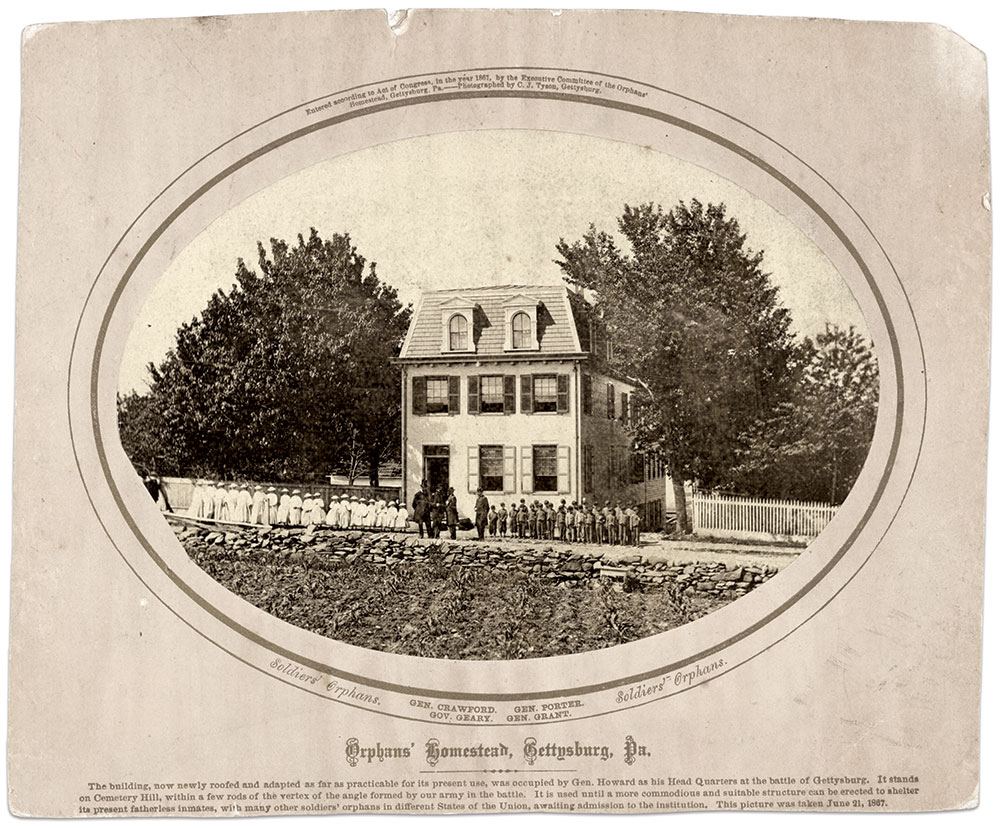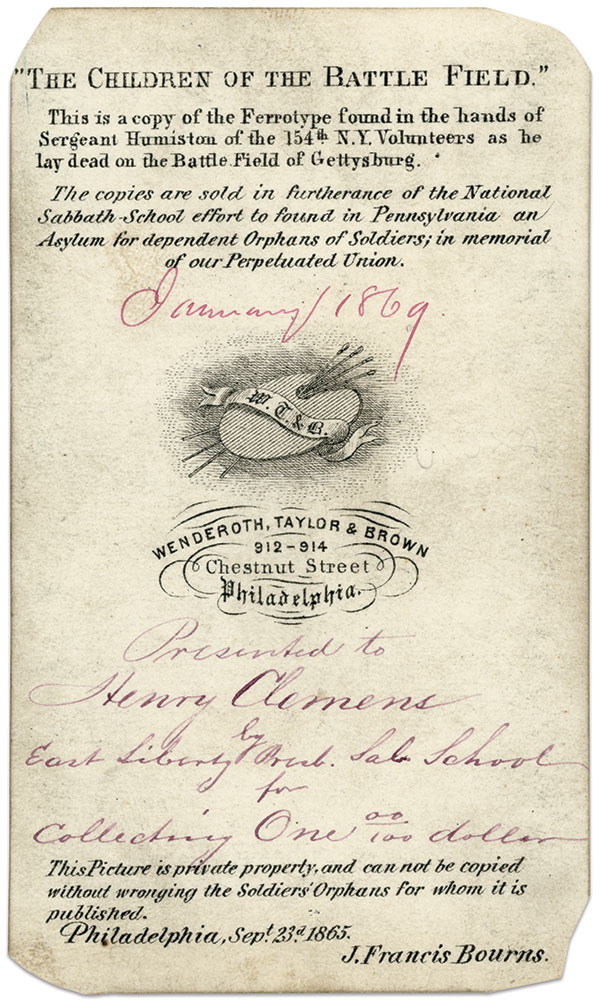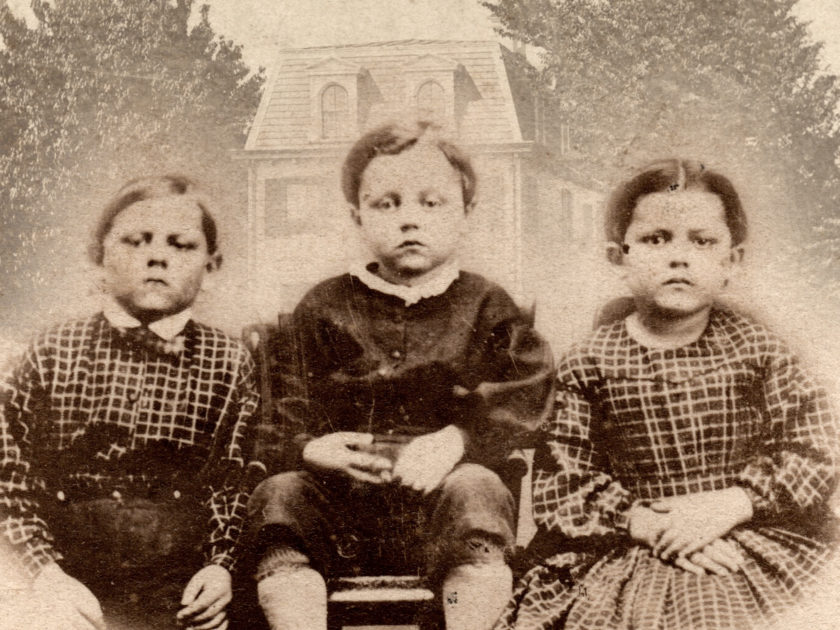By Mark H. Dunkelman and Richard Leisenring, Jr.
On May 9, 1863, Amos Humiston wrote his wife, Philinda, “I got the likeness of the children and it pleased me more than anything that you could have sent me.” He added, “How I want to see them and their mother is more than I can tell.”
Humiston, a sergeant in the 154th New York Infantry, had received the likeness, an ambrotype, while in camp near Stafford Court House, Va.
Less than two months later, the ambrotype was found clutched in his dead hands on the battlefield of Gettysburg. The chaos and confusion of the fighting had left him among the unidentified dead. The photograph proved to be an important clue in reestablishing his identity.
The ambrotype and the poignant story attached to it passed from hand to hand until it reached John Francis Bourns, a Philadelphia physician who had traveled to Gettysburg in the aftermath of the battle to tend to the wounded. Bourns realized the importance of the photograph in the identification of the body.
“The ambrotype was found clutched in his dead hands on the battlefield of Gettysburg. The chaos and confusion of the fighting had left him among the unidentified dead. The photograph proved to be an important clue in reestablishing his identity.”
After he returned to Philadelphia in October 1863, Bourns initiated a wave of newspaper publicity about the unknown soldier and the image of the children. Because photographs could not be reproduced in newspapers, a minute description of the photograph appeared in print.
The October 19 edition of the Philadelphia Inquirer stated, “The children, two boys and a girl, are, apparently, nine, seven and five years of age, the boys being respectively the oldest and youngest of the three. The youngest boy is sitting in a high chair, and on each side of him are his brother and sister. The eldest boy’s jacket is made from the same material as his sister’s dress.”
Bourns had carte de visite copies of the ambrotype made by area photographers in anticipation of responders seeking more information. Moreover, if the soldier and his family were identified, he wanted to have copies to sell as part of an effort to raise money to support the three orphans. These copies, which presented the picture in vignette, sold in local shops to Philadelphians eager to help.

In response to one inquiry about a month after the publicity campaign began, Bourns sent a carte to Portville, N.Y., where Philinda Humiston recognized it as the identical picture of little Franklin (eight), Alice (six) and Frederick (four), she had sent to Amos.
Mass media, philanthropic photo
The Philadelphia religious newspaper that led to the discovery and broke the story of the identification, the American Presbyterian, reported that proceeds from the sales of the cartes de visite would be used “to give each of the children a good education.” Another possible goal proposed: The establishment of a soldiers’ orphans home.
Bourns’ use of cartes de visite for philanthropic purposes was not an original idea. But it was in its infancy. In years to come, the use of photographs for fundraising purposes became widespread.
Bourns sold the cartes at five for one dollar. Less than a month after the identification, the American Presbyterian noted that more than 700 had been sold. About two weeks later, the Philadelphia Inquirer warned the public that an unscrupulous photographer had pirated the image, “thus defrauding the orphans of the money which should be given for their support.” This indicates that Bourns authorized certain photographers to produce the carte to ensure that proceeds would go to the Humistons.
As 1863 gave way to 1864, sales remained brisk. A new version of the carte included the addition of the names of the children on the face of the mount, and a statement about “The Soldier’s Children” on the reverse: “This is a copy of the Ambrotype found in the hands of SERGEANT HUMISTON, of the 154th Regiment New York Volunteers, as he lay dead on the Battlefield of Gettysburg. The proceeds of the sale of the copies are appropriated to the support and education of the Orphan Children.”
As certain authorized photographers produced copies of the carte, so too were certain businesses authorized as agents to sell them. Residents of Gettysburg, for example, could buy them for 25 cents apiece at Dr. Robert Horner’s drugstore.

Bourns visited Portville on Jan. 2, 1864, and returned the original ambrotype to the family. He presented Philinda with money raised from carte sales. The next day, he attended a public reception at the packed Portville Presbyterian Church, at which he offered copies of the photograph for sale in various sizes. They sold in large numbers, including all the cartes. Philinda received the proceeds of $51, almost four months’ pay for a soldier.


Meanwhile, the American Presbyterian sponsored a contest for the best Humiston-inspired poem. Popular poet, composer and balladeer James Gowdy Clark won the competition and set his verses to music. “The Children of the Battle Field” appeared as sheet music, and as the title inscription on cartes de visite of the children.
A new edition of the carte by the Philadelphia firm of Wenderoth, Taylor & Brown included a notice beneath the inscription on the back, which read, “This Picture is private property, and can not be copied without wronging the Orphans for whom it is published. Philadelphia, Dec. 3d, 1864. J. Francis Bourns.”
Subsequent editions by the same firm, dated Sept. 23, 1865, and November 1867 differ in two ways from the previous edition. The word ferrotype appears in place of ambrotype for some inexplicable reason. These images also carried an additional inscription: “The copies are sold in furtherance of the National Sabbath School effort to found in Pennsylvania an Asylum for dependent Orphans of Soldiers; in memorial of our Perpetual Union.”
The latter inscription marked a shift in funding from the Humiston family to the establishment of an orphanage.
In November 1865, the American Presbyterian announced the organization of the Homestead Association to raise money for the home. Sunday schools were targeted as a primary source of fundraising. These schools received Humiston children cartes de visite and copies of the “Children of the Battle Field” sheet music as prizes for their young fundraisers.
The drive proved a success. The orphanage opened on Baltimore Street on East Cemetery Hill in Gettysburg in October 1866, with Philinda Humiston as the institution’s wardrobe mistress, and Frank, Alice, and Fred among the occupants. The Humistons arrived in Gettysburg in advance of the other orphans and staff. On the day they arrived, they visited Amos’ Grave Number 14 in Section B of the New York State portion of the Soldiers’ National Cemetery. The children covered his headstone with flowers.
Enduring legacy
The tale of the Humistons was perhaps the most melodramatic media-driven story of the Civil War that centered on a photograph, and propelled to all corners of the North by cartes de visite and newspapers. The editor of the American Presbyterian, Rev. John W. Mears, asserted in 1867 that photographs of the Humiston children “are almost as familiar as Lincoln’s and Grant’s to the people.”
The cartes remain as familiar to present-day collectors. They represent prime examples of philanthropic photographs. Regional and national charities such as the Union Volunteer Refreshment Saloon in Philadelphia and the numerous U.S. Sanitary Commission fairs issued photographs as fundraising aids. So too did individuals, generally disabled veterans.
The Humiston children carte straddled both categories: Sales first benefitted the Humiston family, and later the orphanage. As such, it became one of the best-known charitable cartes to emerge from the war.
The cartes also served as non-personal photographs. Images of scenic places, artworks and celebrities were inserted into albums alongside portraits of family and friends. Today, many collectors consider these non-personal images as “fillers.” Most celebrity photographs featured prominent politicians, generals and entertainers. Virtually all of the subjects were adults, with the Humiston carte of children a notable exception.
Cataloging variations
In a 1981 Military Images article, the late William Gladstone wrote there were “at least five different” versions of the Humiston children carte. The authors have considerably more variants in their collections. For purposes of analysis, we organized them in two categories: pre- and post-identification.
We presume those without identification were made before the knowledge of the identity of the children was ascertained in November 1863. These images bear the imprints of seven photographers. Three hailed from Philadelphia: Wenderoth & Taylor (“late Broadbent & Co.”), Frederick Gutekunst, and H. C. Phillips & Brother (R. R. Phillips). The other cartes credits go to J.C. Glenn of Mercer, Pa., J.M. Green of Cleveland, Ohio, the New York Photographic Company of New York City, and the Tyson Brothers of Gettysburg.
Two pre-identification cartes, including a rare tinted example, have no back marks. Some are in portrait format, and others in landscape. The Gutekunst images are embossed with “COPY” on the mount below the print, indicating that it was reproduced from the original ambrotype. The Tyson Brothers carte has the handwritten inscription, “Three Children whose picture was found on the Battle field of Gettysburg.” Though it doesn’t identify the Humistons, it does have a tax stamp marked “Tyson 1865,” denoting that it was sold after Humiston’s identification.
Post-identification cartes with “The Soldier’s Children” or “Children of the Battle Field” inscriptions are credited to four photographers. Two of them, Frederick Gutekunst and Wenderoth & Taylor (and their successors, Wenderoth, Taylor & Brown), also produced pre-identified examples. The other two are James E. McClees of Philadelphia and Edward & Henry T. Anthony of New York City. One Wenderoth, Taylor & Brown carte has a secondary imprint, “For sale by J. E. Durand, Waterbury, Ct.,” indicating the Philadelphia firm acted as a sort of wholesaler of the image to other photographic galleries in the North.
One of the post-identification cartes without imprint is unique because of its variant descriptive text. It contains the standard “Children of the Battle Field” inscription, but with slight changes, including an exclamation point at the end of the title. Though signed and dated “J. Francis Bourns, Philadelphia Sept., 1867,” the carte lacks the inscription stating it was sold in support of the Sunday school effort to fund the Homestead orphanage, which appears on the Sept. 23, 1865, and November 1867 editions by Wenderoth, Taylor & Brown. It seems strange that Bourns would publish a carte by an unknown photographer just two months before the November 1867 issue by Wenderoth, Taylor & Brown, the firm he seems to have used most often. These oddities may indicate a pirated carte.
Another unique variation is a carte-sized print pasted onto a portion of an album or scrapbook page with the handwritten inscription, “Frank-Frederick-Alice Ferrotype found in the hands of Sergeant Humiston of the 154th New York Volunteers as he lay dead on the battlefield of Gettysburg.” Nothing is known of its provenance.
Several of the pre- and post-identification cartes included handwritten inscriptions. The presence of such text suggests that these non-personal filler images were treated in the same way as personal images of family and friends. Such inscriptions range from a simple date (“January 11th 1864”) to a wildly inaccurate description (“Found at Gettsburgh in a Bible of a Union soldier killed after the Battle July 1864”). One of the Sept. 23, 1865 Wenderoth, Taylor & Brown cartes has an inscription that ties it firmly to the Sunday school drive to raise funds for the Homestead orphanage, “January 1869. Presented to Henry Clemens by East Liberty Presb. Sab. School for collecting One 00/100 dollar.”
Formats other than cartes de visite are documented earlier in this story, when Bourns visited Philinda in Portville. A reference is also found in a December 1863 issue of the American Presbyterian. The newspaper announced that new subscribers would receive a large photograph of the Humiston children, a value of one dollar.
We are aware of only two extant examples—both large format albumen prints. The descendants of the Humistons possess one, a 9-by-7 inch landscape oval by Wenderoth & Taylor. Delicately tinted, the image’s color scheme matches that in the tinted carte pictured here. The carte was possibly a prototype for the larger image, or perhaps tinted in imitation of it.
The other is in Dunkelman’s collection, another landscape oval by Frederick Gutekunst that measures 5.5 by 7.5 inches. It is attached to an 8-by-9.5 inch rectangular mount with two decorative surrounding lines and the photographer’s imprint in gold. The children’s cheeks and lips are tinted light pink. Below their likenesses, delicately written in pencil, lies the standard inscription found in printed form on “The Soldier’s Children” and “The Children of the Battle Field.”
On the subject of colored versions, a tinted carte sold at auction in January 2020 (unfortunately to neither of the authors) is worth note. It is of the post-identification category published by James E. McClees. The tinting is crude, and uses different colors than the large format example. We speculate the original purchaser applied the watercolor.
Survey
Curious about the availability of the carte and which of the various editions is most readily found, we conducted a survey to catalog examples posted on eBay during the calendar year 2017.
Based on collecting experience, we estimated a score of images would turn up. It proved accurate. Employing a variety of search terms, we found 21 examples. The sellers were scattered across the country, from Maine to California and Wisconsin to Florida, with more in Pennsylvania (where much of the story had evolved) than in any other state.
The cartes most frequently found were by Wenderoth, Taylor & Brown of Philadelphia, with six examples of the Sept. 23, 1865, issue, five of the Dec. 3, 1864, edition, and one of the November 1867 release. Four cartes by Philadelphia’s Frederick Gutekunst came up for bids: two by Wenderoth & Taylor, and one each by E. & H. T. Anthony of New York City and the Tyson Brothers of Gettysburg. One carte had no imprint. Four of the cartes were pre-identification; the remaining 17, post-identification. The sale price of the cartes averaged $121.48. The highest price paid was $202.00, and the lowest, $38.00.
Our findings suggest that anyone who wants to add this iconic image to his or her collection should find it a relatively easy task.
References: William Gladstone, “Children of the Battle Field,” Military Images, Vol. II, No. 5, March-April 1981; Dunkelman, Gettysburg’s Unknown Soldier: The Life, Death, and Celebrity of Amos Humiston; Leisenring, “Philanthropic Photos: Fundraising during and after the Civil War,” Military Images, Vol. XXXVI, No. 2, Spring 2018; James S. Brust, “Filler Cartes de Visite,” Military Images, Vol. XXXVII, No. 4, Autumn 2019.
Mark H. Dunkelman has written and lectured extensively on the history of the 154th New York, Amos Humiston’s regiment. He also created the mural at Coster Avenue in Gettysburg, which depicts Sgt. Humiston and the regiment in action during the Brickyard Fight on July 1, 1863.
Richard Leisenring, Jr., a native of Hopkinsville, Ky., has been an avid collector of Civil War memorabilia since 1967. He has worked in the museum field and as an historical consultant for 44 years, the last 17 as curator of the Glenn H. Curtiss Museum in Hammondsport, N.Y.
SPREAD THE WORD: We encourage you to share this story on social media and elsewhere to educate and raise awareness. If you wish to use any image on this page for another purpose, please request permission.
LEARN MORE about Military Images, America’s only magazine dedicated to showcasing, interpreting and preserving Civil War portrait photography.
VISIT OUR STORE to subscribe, renew a subscription, and more.

